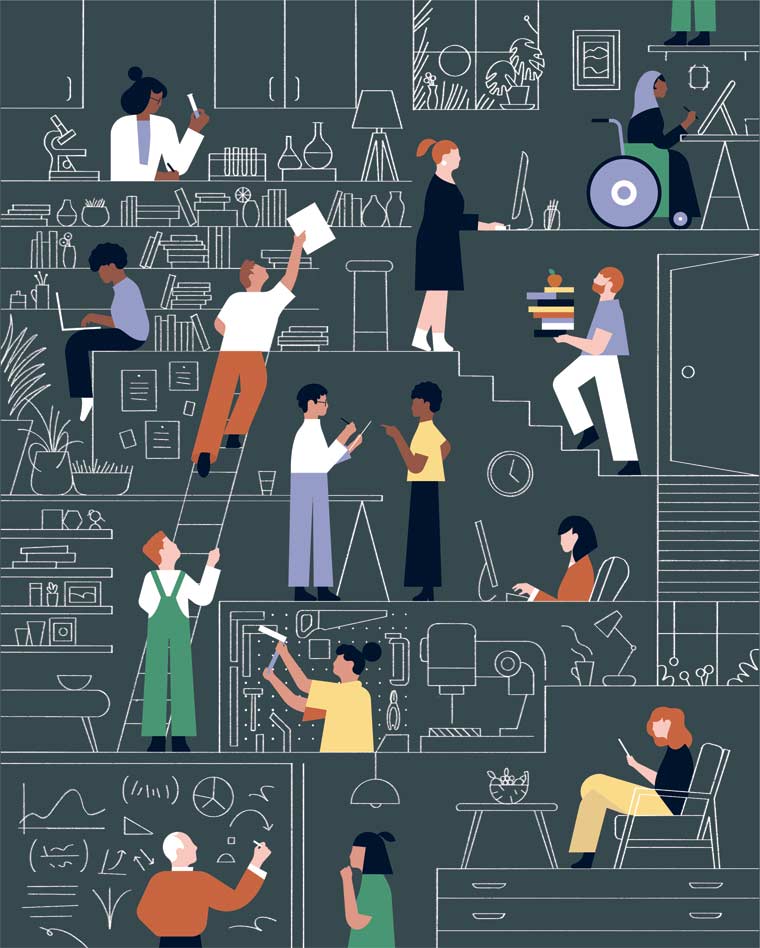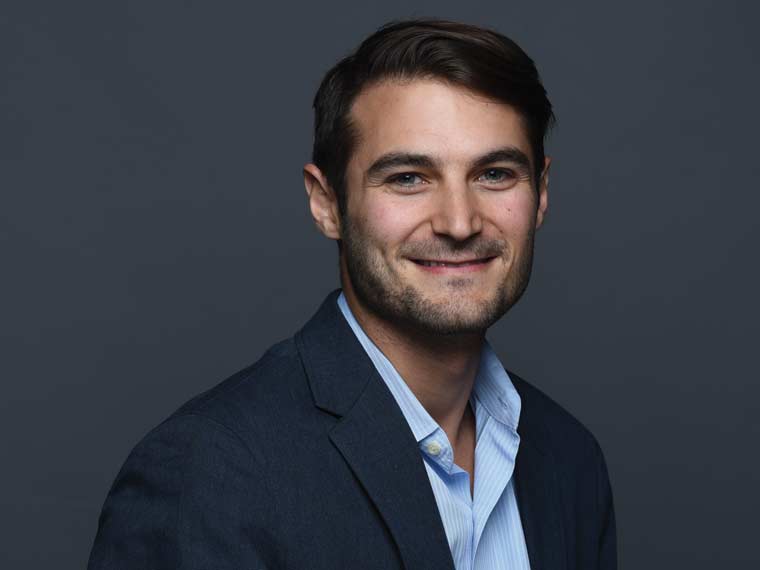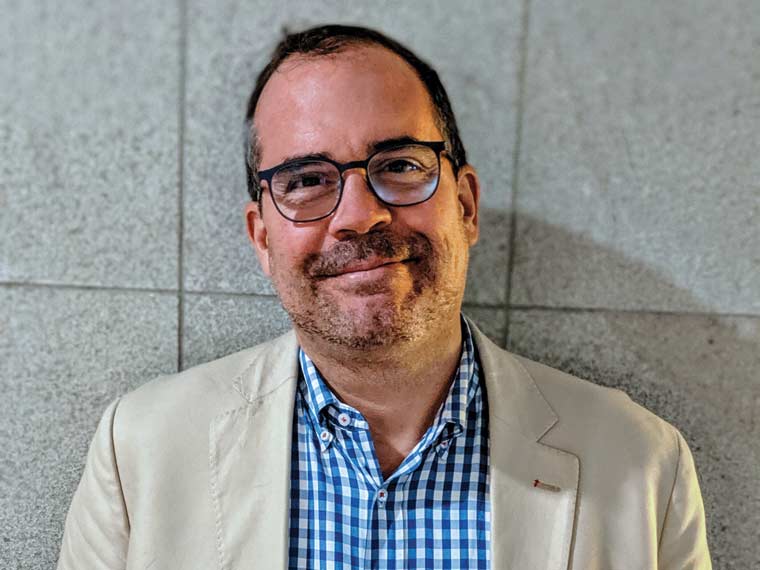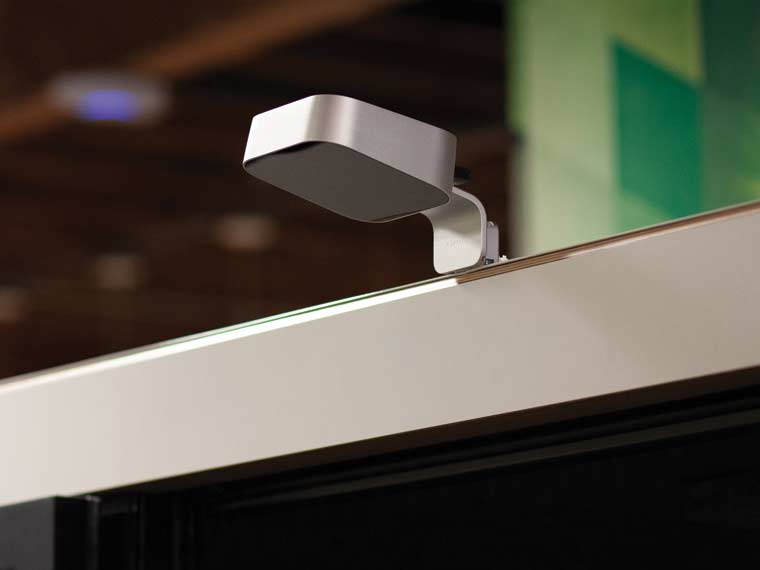Patrick Larvie ’90 and Ari Kepnes ’12 are committed to making your workspace work for you.

Patrick Larvie ’90 doesn’t mean to harp on the failures of architecture, but as a user experience researcher at Google, he always champions function over style. The field of user experience, or UX, aims to make a person’s interaction with a product or environment as frictionless as possible. In Larvie’s view, an eye-catching office building doesn’t always translate into good UX for the people who work there. “I typically come across as mean and grumpy about architects, but we live in this world where good architecture is what wins a Pritzker Prize, not what’s useful and helpful to people,” he says. “Nobody cares if that award-winning office space helps people get their work done. Nobody asks that question.”
At Google, Larvie and his research team ask themselves that question every day. As global lead of the Workplace User Experience Team, he focuses on how to create more user-centered environments for employees. The work encompasses everything from choosing the best fonts for clear signage to selecting the most efficient heating and cooling system for an office building.
Larvie shares this passion for designing a more efficient workplace with fellow alumnus Ari Kepnes ’12. Although they graduated more than two decades apart, Larvie and Kepnes connected while both were living in San Francisco. Kepnes is the director of market research for Density, a company that makes people-counting sensors to better understand how physical space is used. With these analytics in hand, businesses can redesign the workplace to optimize productivity. “The whole world of digital design for products like websites and apps is based on designing something, iterating over and over, and making it better,” Kepnes says. “That premise is finally being applied to the physical world.”
Both credit their time at Sarah Lawrence for shaping their thought process and approach to problem solving. Kepnes, who studied the intersection of technology, media, and psychology, credits professors such as Una Chung (literature; women’s history), Shahnaz Rouse (sociology; women’s history), and Bella Brodzki ’72 (literature) for expanding his worldview. Larvie has found that his liberal arts education taught him to consider cultural and historical context. “When I think about things like fonts and heating and cooling systems, I like to think of them in historical ways,” he says. “At Sarah Lawrence, we thought of everything that way.”
For example, the concept of a modern office came about in the late 19th century, when steel girders allowed for floors with large open spaces instead of smaller, separated rooms with load-bearing walls. Until the 1960s, these open areas were populated by clerical workers who sat at tables, while higher-ups occupied windowed offices on the building’s perimeter. This layout shifted with the invention of the cubicle, by Robert Propst, in 1967. Propst felt strongly that employees needed a space they could personalize and a certain amount of privacy to be productive. Despite his good intentions, the cubicle eventually came to symbolize the monotony of office work. In the 2000s, Silicon Valley tech companies such as Facebook and Apple started to embrace the open floor plan as a refreshing alternative to “cube farms.” Their original intent was to foster collaboration and creativity.
In reality, research has found that open floor plans can decrease employee satisfaction and productivity while increasing distractions, stress, and the number of sick days taken. “We have good reason to believe these open office spaces are the UX equivalent of a dumpster fire,” Larvie says.
At Density, Kepnes helps customers such as the University of Notre Dame, Marriott, and Dropbox use its people-counting sensors and the resulting occupancy data to create user-centric physical spaces. For example, sensors in Notre Dame’s dining facility track how many students eat in the cafeteria and when they come in. Now the kitchen staff knows when to expect an influx of hungry students and how much food to prepare.
“Our sensors can count how many people are in every building, room, and floor of a large piece of real estate at any given time,” Kepnes says. “We are able to do that with state-of-the-art technology that scans and recognizes human movement to discern with precision how many people are in every space—but without invading people’s privacy.”
Instead of video cameras, Density uses Depth Processing Units (DPUs), installed above doorways, that shine invisible infrared light to scan the area underneath. The DPU captures hundreds of thousands of depth readings every second, creating relief images—like a topographic map that depicts people instead of mountains. Meanwhile, computer algorithms process the data in real time. “Sensing technology is doing something that we should have done a very long time ago, which is enabling people to place demands on their physical environments and make sure they are living up to expectation,” Larvie says.
After earning a PhD in psychology from the University of Chicago, Larvie worked as a research director at a nonprofit policy think tank in Brazil. One of his projects involved redesigning the information management system used by police in the state of Rio de Janeiro to report crimes and conflict. He realized that technology—UX, in particular—has the power to change institutions and influence public policy.
After Kepnes graduated from Sarah Lawrence, he used the Office of Career Services to find a job at ZEITGUIDE, a consulting and publishing platform, where he worked with several fellow alumni. A few years later, he moved to Density, whose mission aligned well with his beliefs in user-centered design. “So much of the way cities and buildings are built is based on assumptions about how they are going to be used,” he says. “They are managed in a way that is devoid of how people are using the space.”
Last April, Larvie and Kepnes discussed the cross-disciplinary field of user experience at an alumni event in San Francisco, spreading the gospel of good UX. With such passionate advocates, the days of style over function—in buildings, workspaces, cities—could become a thing of the past.
Written by Meeri Kim
Illustrated by Jamie Jones
Photos of Ari Kepnes and device courtesy of Density
Photo of Patrick Larvie by Ken Linton

“The whole world of digital design for products like websites and apps is based on designing something, iterating over and over, and making it better. That premise is finally being applied to the physical world.”
Ari Kepnes ’12

“Sensing technology is doing something that we should have done a very long time ago, which is enabling people to place demands on their physical environments and make sure they are living up to expectation.”
Patrick Larvie ’90

Density’s unobtrusive technology allows companies to measure and analyze how spaces are used without capturing personally identifiable information.